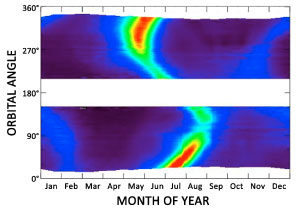Data: Version 3 (V3) Release
Improving the accuracy of Aquarius measurements is a key activity to ensure that the data are most useful for science and society.
Scientists and engineers work together continuously to test and refine algorithms, or step-by-step procedures for calculations,
used to process Aquarius' ocean surface salinity data. The result is periodic updates to the data processing, such as Version
3 (V3).
Working on processing algorithms goes hand-in-hand with calibration and validation (or "Cal/Val"). Calibration is the process of
correlating the instrument readings with a standard to check its accuracy. Validation occurs when the instrument's accuracy is proven; for
Aquarius, this is accomplished using data from computer models and in-water buoys.
Key steps that have been improved in the V3 data release are shown in bold letters in the "Cal/Val Steps" table (at right). Italics show interim values calculated during the Cal/Val process.
The movie begins by transitioning from V2 to V3 data on a global map, followed by a V2-to-V3 transition focused on an area in the eastern equatorial Pacific Ocean. Orange colors depict relatively high salinity (> 37) while dark blues show relatively low salinity areas (< 33).
The movie at left illustrates where Aquarius data were acquired (i.e., green ovals) relative to its orbital path. It begins with the satellite descending on the visible side of Earth.
Next, ascending orbits crossed near the north pole and descended on the opposite side. Finally, it shows where ascending and descending swaths overlapped. Comparing data from these areas of overlap helped to understand how to correct for galactic reflection off the ocean surface.
Examining V2 ascending versus descending data has resulted in a more accurate "Geometric Optics" (GO) model for V3, which takes into account orbit position (y-axis in the graph at left - click to enlarge) versus month (x-axis). Red values are equivalent to corrections of 6 practical salinity units, 30 times the desired monthly accuracy of the Aquarius measurement.
Extensive data analysis has shown that models using H-polarization data from the scatterometer and radiometers provide optimal performance in terms of correcting for surface roughness effects. For example, these models performed well on data collected from storms with very high winds and rain (e.g., Hurricane Katia in 2011). Thus the V3 data release algorithm features a new roughness correction model, which helps to significantly improve the accuracy of Aquarius' salinity measurements.
Thanks to V3, this team was well "prepped" for yet another set of challenges. Click here to learn about the updates in Version 4(V4) of the Aquarius data processing.
| Cal/Val Steps |
|---|
Counts from Each Radiometer |
Calibration of Radiometer Data |
Total Antenna Temperature |
Remove Space Contributions |
Earth Antenna Temperature |
Remove Antenna Pattern Effect |
Earth Brightness Temperature (BT) |
Correct for Faraday Rotation |
Top of Atmosphere BT |
Remove Atmospheric Contribution |
Ocean Surface BT |
Remove Surface Roughness Effects |
Specular BT |
Match to Computer Models & In-Water Data |
Salinity! |
Key steps that have been improved in the V3 data release are shown in bold letters in the "Cal/Val Steps" table (at right). Italics show interim values calculated during the Cal/Val process.
How Does V3 Compare to V2? See for Yourself!
The movie at left compares data processed using Version 2 (V2) and V3 algorithms. Maps are from September 2011, the first full month during
which Aquarius salinity data were collected.The movie begins by transitioning from V2 to V3 data on a global map, followed by a V2-to-V3 transition focused on an area in the eastern equatorial Pacific Ocean. Orange colors depict relatively high salinity (> 37) while dark blues show relatively low salinity areas (< 33).
Removing Reflected Galactic Radiation ("Space Contributions")
Reflection of the galaxy on the ocean surface has a big impact on the quality of Aquarius' salinity data. This became clear when comparing
V2 data collected over the same area when the satellite was ascending versus descending in its orbit. Why? The Aquarius
pointing geometry is tilted (i.e., not pointing straight down) and the ocean surface can act like a mirror. Depending on which direction
the satellite is moving, galactic radiation can be reflected toward or away from the instrument.The movie at left illustrates where Aquarius data were acquired (i.e., green ovals) relative to its orbital path. It begins with the satellite descending on the visible side of Earth.
Next, ascending orbits crossed near the north pole and descended on the opposite side. Finally, it shows where ascending and descending swaths overlapped. Comparing data from these areas of overlap helped to understand how to correct for galactic reflection off the ocean surface.
Examining V2 ascending versus descending data has resulted in a more accurate "Geometric Optics" (GO) model for V3, which takes into account orbit position (y-axis in the graph at left - click to enlarge) versus month (x-axis). Red values are equivalent to corrections of 6 practical salinity units, 30 times the desired monthly accuracy of the Aquarius measurement.
Removing Antenna Pattern Effects
The V3 data processing includes a relatively minor adjustment of the antenna pattern. It improves data collected during "cold sky calibration"
maneuvers, when the satellite observatory rotated 180 degrees from the normal Earth-viewing mode to measure space, which has a well-established
and consistent temperature. Likewise, V3 better corrects for data collected from "hot" calibration scenes over land.Removing Ocean Surface Roughness Effects
The Aquarius V3 data processing algorithm takes better advantage of data collected by the onboard scatterometer, which is
used to calculate ocean roughness concurrently with the radiometers' brightness temperature
measurements. Like the radiometers, the scatterometer measured signals both in horizontal (H) and vertical (V) polarizations.
Unlike the radiometers, which passively measured natural radiation from the ocean surface, the scatterometer actively emitted
radar pulses. Ocean roughness is derived from the change in these signals after they "bounced" off the sea surface. Extensive data analysis has shown that models using H-polarization data from the scatterometer and radiometers provide optimal performance in terms of correcting for surface roughness effects. For example, these models performed well on data collected from storms with very high winds and rain (e.g., Hurricane Katia in 2011). Thus the V3 data release algorithm features a new roughness correction model, which helps to significantly improve the accuracy of Aquarius' salinity measurements.
Matching to Computer Models and In-Water Data
Validation against in-water salinity measurements from the ARGO drifter network
and output from computer model runs revealed the need for additional minor adjustments to V3 salinity data, which are correlated with sea
surface temperature. The likely cause is small uncertainties in the radiative transfer model used in the data processing algorithm, which
relates electromagnetic radiation to ocean surface properties. Thus in addition to a "standard" salinity product, V3 provides an "adjusted"
salinity that has been fine tuned to sea surface temperature measurements obtained from other sources (e.g., buoys and satellite infrared
sensors).Other V3 Features and What's Next
The Aquarius Cal/Val team also refined the V3 data processing algorithm to filter undetected
radio frequency interference (RFI) and flagging or masking instances of degraded algorithm
performance (e.g., presence of sea ice, very high wind speeds, etc.).Thanks to V3, this team was well "prepped" for yet another set of challenges. Click here to learn about the updates in Version 4(V4) of the Aquarius data processing.



